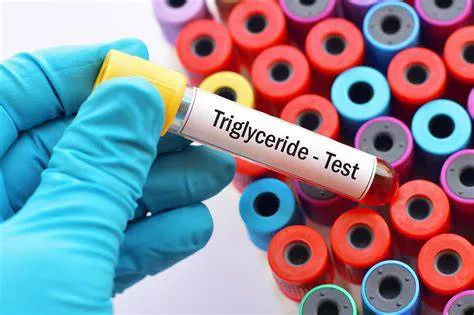In the realm of cardiovascular health, cholesterol levels are often a point of concern and focus. Among the various lipid parameters, LDL (low-density lipoprotein) cholesterol and triglycerides play crucial roles in assessing cardiovascular risk. However, it can be puzzling when someone presents with high LDL levels but concurrently low triglyceride levels. This phenomenon, often termed the “LDL-C/triglyceride paradox,” raises intriguing questions about lipid metabolism, genetic predispositions, lifestyle factors, and potential implications for cardiovascular health.
The Basics of Cholesterol and Triglycerides
Before delving into the paradox, it’s essential to understand the basics of cholesterol and triglycerides. Cholesterol is a waxy substance vital for building cells and producing certain hormones. It circulates in the blood attached to lipoproteins, with LDL being labeled as “bad” cholesterol due to its role in plaque formation in arteries. Triglycerides, on the other hand, are a type of fat used for energy and stored in fat cells. They also circulate in the blood within lipoproteins, primarily VLDL (very-low-density lipoprotein).
LDL-C/Triglyceride Paradox: Unraveling the Mystery
1. Metabolic Pathways and Genetic Factors: One explanation for high LDL and low triglycerides lies in the intricate metabolic pathways that govern lipid metabolism. Genetic factors can influence how cholesterol and triglycerides are processed and transported in the body. Certain genetic variations may lead to increased LDL production or reduced clearance, contributing to elevated LDL levels. At the same time, efficient triglyceride metabolism pathways may keep triglyceride levels low despite high LDL.
2. Lifestyle and Dietary Influences: Another factor contributing to this paradox is lifestyle and dietary habits. A diet rich in saturated fats, trans fats, and cholesterol can raise LDL levels. However, it may not significantly impact triglyceride levels if the individual has an efficient triglyceride clearance mechanism. Conversely, consuming excess carbohydrates and sugars can elevate triglyceride levels while not affecting LDL as directly.
3. Insulin Resistance and Metabolic Syndrome: Insulin resistance, a hallmark of metabolic syndrome, can play a role in the LDL-C/triglyceride paradox. Insulin resistance impairs the body’s ability to utilize glucose effectively, leading to higher insulin levels. Elevated insulin levels can stimulate VLDL production in the liver, increasing triglyceride levels. Meanwhile, LDL levels may rise independently due to other factors, creating the paradoxical scenario of high LDL and low triglycerides.
4. Medications and Medical Conditions: Certain medications, such as statins used to lower cholesterol, can influence lipid levels and potentially contribute to the LDL-C/triglyceride paradox. Additionally, medical conditions like familial hypercholesterolemia (FH) or familial combined hyperlipidemia (FCH) can lead to elevated LDL levels despite low triglycerides, highlighting the genetic component in lipid metabolism disorders.
Clinical Implications and Risk Assessment
Understanding the LDL-C/triglyceride paradox is crucial for assessing cardiovascular risk accurately. While high LDL levels are traditionally associated with increased cardiovascular risk, the presence of low triglycerides may modify this risk profile. Research suggests that individuals with high LDL and low triglycerides may have a more favorable cardiovascular risk profile compared to those with elevated levels of both lipids.
1. Atherogenic Index: The atherogenic index, calculated as the ratio of total cholesterol to HDL cholesterol, provides valuable insights into lipid-related cardiovascular risk. However, in the context of the LDL-C/triglyceride paradox, incorporating triglyceride levels into risk assessment models can offer a more comprehensive view. A higher atherogenic index despite low triglycerides may indicate a greater risk due to elevated LDL levels.
2. Inflammatory Markers and Imaging Studies: Beyond lipid levels, assessing inflammatory markers like C-reactive protein (CRP) and conducting imaging studies such as coronary calcium scoring can further refine cardiovascular risk assessment. Inflammation plays a significant role in atherosclerosis, and individuals with high LDL and low triglycerides may still exhibit increased inflammation and plaque burden, necessitating targeted interventions.
3. Personalized Treatment Approaches: Recognizing the LDL-C/triglyceride paradox underscores the importance of personalized treatment approaches in managing cardiovascular risk. While statins are commonly prescribed to lower LDL, additional therapies targeting triglycerides or addressing underlying insulin resistance may be warranted in individuals with this paradoxical lipid profile.
Lifestyle Interventions and Management Strategies
For individuals with high LDL and low triglycerides, adopting healthy lifestyle interventions can be instrumental in improving lipid profiles and overall cardiovascular health.
1. Dietary Modifications: Emphasize a heart-healthy diet rich in fruits, vegetables, whole grains, lean proteins, and healthy fats like omega-3 fatty acids. Limit intake of saturated fats, trans fats, refined sugars, and processed foods to help lower LDL and triglyceride levels.
2. Regular Exercise: Engage in regular physical activity, aiming for at least 150 minutes of moderate-intensity exercise per week. Physical activity helps lower LDL levels, improve insulin sensitivity, and promote overall cardiovascular fitness.
3. Weight Management: Maintain a healthy weight through a balanced diet and regular exercise. Excess body weight, especially abdominal obesity, can contribute to insulin resistance and dyslipidemia, exacerbating the LDL-C/triglyceride paradox.
4. Smoking Cessation and Stress Management: Quit smoking if applicable, as smoking is a significant risk factor for cardiovascular disease. Practice stress-reducing techniques such as mindfulness, meditation, or yoga to lower stress levels and promote cardiovascular wellness.
Conclusion
The LDL-C/triglyceride paradox presents a fascinating conundrum in lipid metabolism and cardiovascular health. While high LDL levels are conventionally viewed as a risk factor, the presence of low triglycerides can modify this risk profile and necessitate a nuanced approach to risk assessment and management. Understanding the underlying mechanisms, including genetic factors, lifestyle influences, and metabolic pathways, is essential for providing personalized care and optimizing cardiovascular outcomes. By incorporating lifestyle interventions, monitoring inflammatory markers, and considering individual risk factors, healthcare providers can navigate this paradox effectively and empower individuals to take proactive steps towards heart health.


